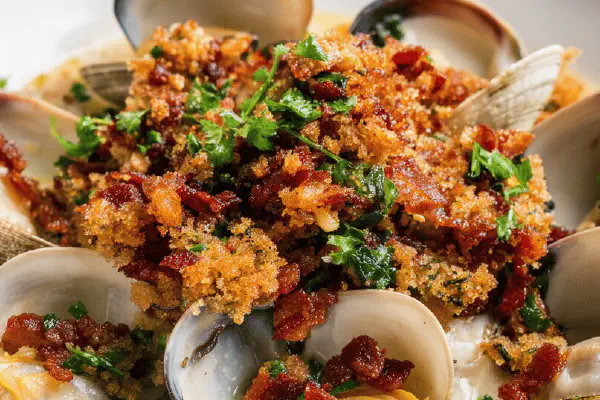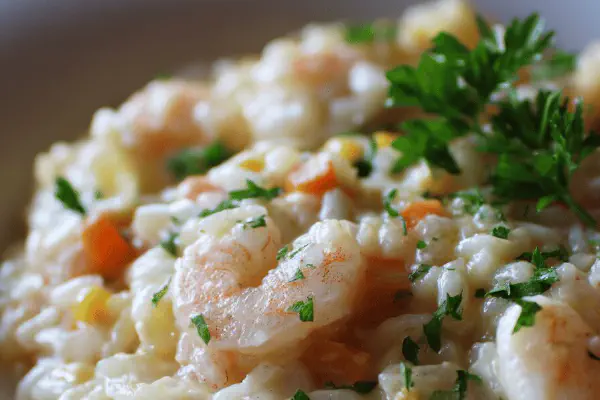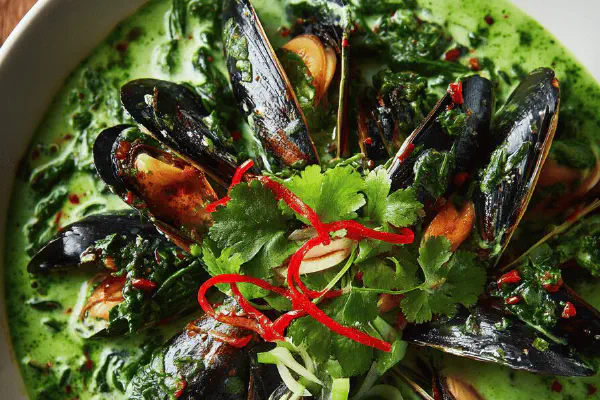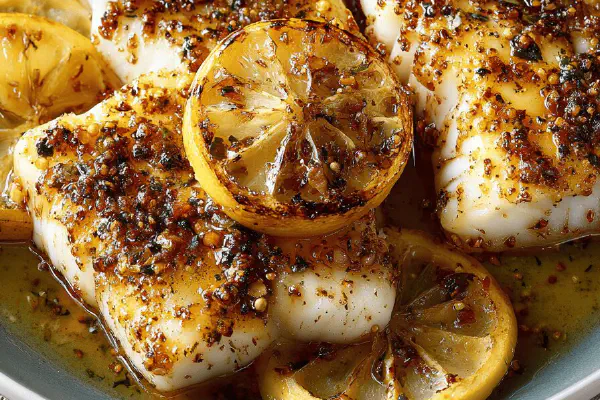Clams White Wine Bacon Crumble

E
By Emma
Certified Culinary Professional
•
Recipe tested & approved
Clams steamed in white wine with a creamy finish. Topped with a crunchy crumble of stale bread, parsley, garlic, and crispy pancetta instead of bacon. Shallots replace French shallots for a sharper bite. Subtle smoky notes from pancetta blend with fresh herbaceous crunch. Broth reduced for deep flavor, not watery. Crumble toasted until golden, not burnt, for texture contrast. A fast, all-day favorite—relearning timing for perfect clam opening without rubberiness. A versatile dish that thrives with crusty bread or as a starter. Simple tweaks on a classic seafood comfort with a twist.
Prep:
25 min
Cook:
30 min
Total:
55 min
Servings:
2 servings
#seafood
#French-inspired
#simple
#dinner
#quick
#comfort food
#wine
Forget the usual bacon and French shallots. Tried those too many times, ended with bland crumb or watery broth. Here’s what worked—pancetta for smoky depth, normal shallots cause sharper flavors pop. Crumble’s bulkier, chunkier to maintain max crunch. Bread cubes toasted just right—contracts moisture slowly, so don’t rush. Clams steamed until all open but watch out for that rubbery texture—takes focus, not just timer. Reduce broth but not too much; rich, glossy, clings without syruping. Cream is optional but tips balance to round texture. The aroma the wine reduction delivers? Sharp, savory with a creamy whisper. Assembly is critical—serve and garnish immediately or crumble sogs. Learned that the hard way. Small tweaks, big jumps in flavor and texture. Pantry-friendly and quick, yet smells and tastes like you’ve laboured all day. Impressive, efficient — and you get a glow from the seafood minerality.
Ingredients
Crumble
- 30 g (3/4 cup) stale white bread cubes, crusts removed
- 20 g (1/2 cup loosely packed) flat-leaf parsley leaves
- 1 slice pancetta, finely diced
- 1 small garlic clove, minced
Clams
- 1 small shallot, finely chopped
- 1 small garlic clove, finely chopped
- 20 g (1 1/2 tbsp) unsalted butter
- 150 ml (2/3 cup) dry white wine
- 1 kg (2.2 lb) fresh clams, cleaned
- 60 ml (1/4 cup) heavy cream 35%
- Freshly ground black pepper
About the ingredients
Bread’s always tricky. Ripe day-old or older white bread without crust is best—too fresh and the crumble sogs, too stale and it can burn fast. Parsley flat-leaf adds freshness and herbaceousness; flat-leaf over curly for stronger flavor. Pancetta checks the salty, smoky box better than bacon’s often too sweet or fatty profile. Garlic finely minced, just enough for aroma without punch. Substitute pancetta with smoked ham or rendered chorizo for a different twist. Shallots: I chose common shallots over French; bite sharper, pairs better with pancetta. White wine must be dry, no fruity notes or sweetness—avoid Riesling or Moscato. Heavy cream smooths the sauce but can be reduced or replaced with half-and-half if desired—less rich but still silky. Butter for sautéing is non-negotiable, adds depth; olive oil is too strong here. Clams need thorough cleaning; soak in cold salted water with an equal amount of cornmeal to purge sand. Plan ahead; gritty clams ruin whole dish.
Method
Clams
- 1. Melt butter over medium heat in a large pot. Add shallots and garlic, cooking gently until translucent and aromatic, about 3 to 4 minutes. Avoid browning; you want sweetness, not bitterness.
- 2. Pour in white wine, bring to a steady boil, then let it simmer just long enough to reduce by a quarter—look for slightly thickened liquid, about 3 minutes. The smell intensifies here, a sign your broth is concentrating.
- 3. Add clams, cover immediately. Steam until all clams have popped open, roughly 4 to 6 minutes. No peeking too often; heat drops each time and clams take longer. Toss any stubborn, unopened shells—usually dead and bitter.
- 4. With a slotted spoon, transfer the clams to a bowl. Increase heat to high. Boil the cooking liquor briskly until reduced to about 125 ml (1/2 cup). Should coat the back of a spoon, glossy and fragrant. Off-heat, stir in cream, swirl gently to combine. Add clams back in, warm gently for 2 minutes, stirring to coat. Season just with pepper; clam saltiness rarely needs more. Set aside, keep warm.
Crumble
- 1. Pulse bread cubes and parsley in a food processor until coarse crumbs form. Toss in diced pancetta and minced garlic, pulse 2 or 3 bursts—texture should be grainy, not paste-like. Too fine and you lose crunch.
- 2. Heat a non-stick skillet over medium. Add crumble mix, spread evenly. Stir frequently for about 10 to 12 minutes until golden with crispy bits. Listen for sizzles, smell toasty herbs mingling with smoky pancetta. Burnt bits turn bitter, so keep it moving.
- 3. Let cool on a plate; the crumble stiffens and gets crisp.
Assembly
- Divide clams and sauce between shallow bowls. Sprinkle crumble over each, adding that crunch contrast immediately before serving.
- Optional quick hack: If no food processor, finely chop bread and parsley by hand, fry crumble in smaller batches to maintain crispness.
- Serve with crusty bread for soaking up juices or lightly dressed greens for freshness.
- Store leftover crumble airtight—re-toast before using.
- Avoid overcrowding clams in pot—steam evenly to prevent some rubbery, some undercooked. Timing tricky but key.
- If shell grit remains, soak clams in cold salted water with cornmeal for a couple of hours beforehand—this draws out the grit.
- No pancetta? Use thick-cut smoky ham or drop in a touch of smoked paprika for that hammy depth.
- Cream optional—skip for lighter broth, but sauce won’t be as luxurious.
- Don’t overreduce the broth; it should still swim clams, not turn syrupy.
- Balance garlic in crumble: too much overwhelms; too little, blandness.
- Fresh parsley gives brightness. Dried herbs won’t work here.
- Watch crumble closely—once it starts changing color, it’s seconds away from burning.
- Planning a shortcut? Buy toasted bread crumbs and add pancetta and parsley; it’s close but less fresh.
- For more heat, toss pinch of red chili flakes into butter when cooking shallots.
- Use dry white wine with character but no residual sugar—so Sauvignon Blanc, Pinot Grigio work well.
- If clams have stubborn unopened ones after cooking, discard immediately to avoid bitterness.
- Reheating? Gentle, low heat to avoid toughening clams; crumble loses crunch if reheated.
- Serve immediately for best textural contrast and fresh aroma.
Cooking tips
Cooking clams is less about time, more about watching and hearing. When the pot covers, steam builds—the clams start to open sequentially. After first sets open, listen for incessant clacking shells, that’s the signal to check carefully; overcooking makes them tough. Reduce broth with high heat; you’ll see bubbles turning more vigorous and the liquid thickening. Testing viscosity by spoon coating is better than timing rigidly. Crumble needs constant stirring to avoid any blackened bits. Cooking low and slow results in chewy rather than crunchy, so medium heat with attention wins. Let crumble cool on a plate away from steam and moisture; humidity kills crispness. Combining the clams back with the creamy wine reduction warms everything just before serving without overcooking. Reserve any leftover broth—it’s magic spooned over pasta or rice. Don’t forget seasoning only at the end—clam saltiness varies wildly. Freshly ground pepper adds the final bite, no salt added usually.
Chef's notes
- 💡 Keep heat steady medium for butter sautée. Browning kills sweetness—shiny translucent shallots signal right time. Garlic minced fine but not paste. Overcooking garlic bites harshly.
- 💡 White wine reduction needs watching. Should shrink by a quarter only. Smell changes from sharp to deep fruity herb. Too long, broth thickens syrupy and clams suffer swimming in glue-like base.
- 💡 Steam clams covered, no poking. Quiet moments mean clam shells cracking open. Usually 4 to 6 mins. Unopened shells are dead, toss—bitterness follows otherwise. Timing not rigid, more sensory than clock.
- 💡 Crumble pulse coarse crumbs—fine powder kills crunch. Mix diced pancetta last, just 2-3 short pulses. Too much blending smears fats, lose texture contrast. Toast crisp, stirring constantly. Burnt bits bitter, smell warns early.
- 💡 Cream optional, but swirl in off heat. Stir gently to marry sauce without breaking. Sauce sticks to clams, rounds edges. If skipped, broth sharper, less body. Pancetta subs: smoky ham or paprika dusting for smoky depth.
Common questions
Can I use bacon instead of pancetta?
Possible but bacon sweeter or fattier. Pancetta cleaner smoky. If bacon used, trim fat or crisp before adding crumble mix. Adjust salt.
How to avoid rubbery clams?
Steam covered, no peeking. Watch shells pop open, slow simmer. Don’t overcook or heat high. Toughness happens quickly—better slightly under than late. Dead shells toss fast.
Can I prepare crumble ahead?
Yes, pulse and toast crumble early. Cool fully, store airtight in fridge. Re-toast before serving. Too long stale—lose crunch. Chopped by hand okay if no processor but longer cook time.
How to clean clams properly?
Soak cold water salted with cornmeal, two hours minimum. Cornmeal triggers clams to purge grit. Change water once if very sandy. Inspect shells, scrub for dirt outside. Fresh clams work best.



